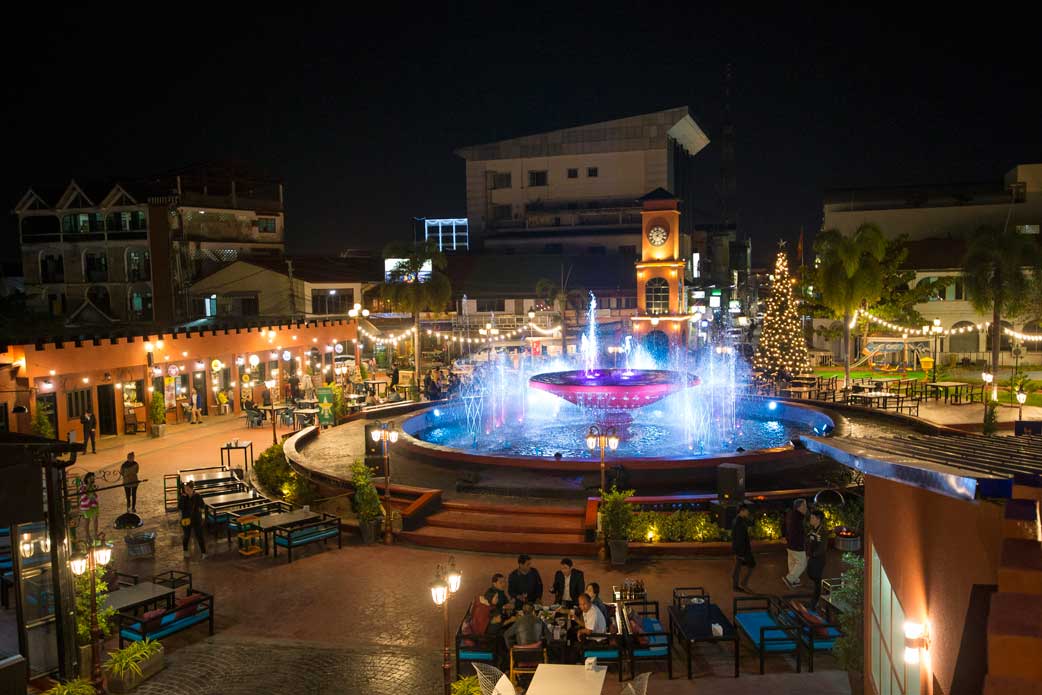A clock tower in a village square is not an unusual sight in a historic city like Vientiane. Nor is a fountain in a plaza, surrounded by tables and chairs and bordered by restaurants and cafes, as traffic moves through the surrounding streets.
Vientiane Capital has both, but look closely, and you’ll notice that the attractive terracotta shade of the tower and fountain is unusually fresh, and the whole area feels a tad more spic and span than the rest of the city centre.
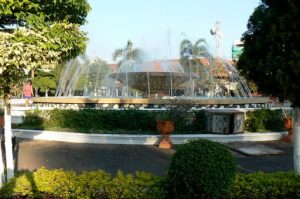 Although the effect is one of timelessness, Nam Phou Park, as it is now known, has been through many iterations and three generations since it was first built. Indeed, the fountain itself is almost the only constant, an official landmark with its own signs pointing the way for tourists.
Although the effect is one of timelessness, Nam Phou Park, as it is now known, has been through many iterations and three generations since it was first built. Indeed, the fountain itself is almost the only constant, an official landmark with its own signs pointing the way for tourists.
When Anouza Phothisane was growing up in Vientiane in the 1990s, he used to play soccer in the fields just beyond Nam Phou.
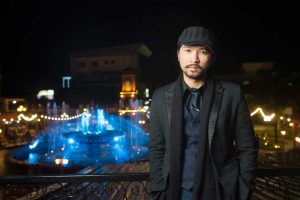
The decades-old landmark, with the fountain that bloomed throughout the day and on many evenings, was one of the central features of downtown Vientiane, the site of the city’s first morning market, a meeting place, a place of civic pride. Rising from the centre of a paved plaza, the fountain was surrounded by French colonial-style buildings housing restaurants and cafes, many of which became their own iconic landmarks over the years, like the Scandinavian Bakery and Le Cave des Chateaux.
But, by the time Anouza was a teenager and young adult in the early 2000s, Nam Phou had become something else, a dark corner of the city centre. Around 2006, the fountain was switched off to discourage young people gathering in the square, which had become a known as a place of disrepute.
“That was when the government asked developers to come in and transform it into a nicer public place, something lighter and more welcoming,” says Anouza.
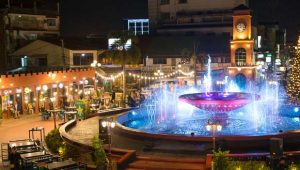 A bar went up, several pop-up stalls, and a demountable stage. It was nothing special, but kept the space alive and the undesirables away. But the fountain’s landmark status gradually diminished. Although a grand enough stone structure, the fountain was no longer visible from the city’s main thoroughfare, and its original purpose was lost.
A bar went up, several pop-up stalls, and a demountable stage. It was nothing special, but kept the space alive and the undesirables away. But the fountain’s landmark status gradually diminished. Although a grand enough stone structure, the fountain was no longer visible from the city’s main thoroughfare, and its original purpose was lost.
Meanwhile, on the banks of the Mekong several streets away, another kind of outdoor gathering spot has been rapidly taking shape. Walking Street, the nightly market and food-fest that fills the lanes and courtyards of the Vientiane New World shopping complex with lights and people, is the brainchild of Anouza himself, an alternative nightspot for Vientiane residents. He has since followed up with several more iterations of the concept in town – M Park, near the Culture Hall, and Si Khai Park, past the airport – and has watched as the local night scene has morphed in the space of less than a year.
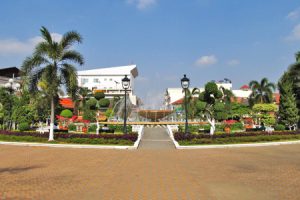 With this kind of magic touch, it was inevitable that the concession owners of Nam Phou would come calling. Anouza took the call in October, and with just two months to transform the space, he set about researching the area’s history, and re-imagining its purpose into a modern context. Even for residents, the transformation seemed to happen in the blink of an eye: the temporary structures were taken down, the clock tower went up, and the whole place cleaned and painted in time for the start of high season in December.
With this kind of magic touch, it was inevitable that the concession owners of Nam Phou would come calling. Anouza took the call in October, and with just two months to transform the space, he set about researching the area’s history, and re-imagining its purpose into a modern context. Even for residents, the transformation seemed to happen in the blink of an eye: the temporary structures were taken down, the clock tower went up, and the whole place cleaned and painted in time for the start of high season in December.
With strings of lights, packing crate-seats and tables, and a laid-back vibe, the place has the now-familiar Walking Street touch. But Anouza is adamant that he wanted to keep the history of the place alive.
“We’ve kept it in the colonial style, because all the buildings around here are examples of the old French architecture,” he says.
“It’s the only place left in Vientiane where they’re all together in one place, so I didn’t want to change the concept. I just put more modern overlay on it, to keep it attractive to tourists.”
 He says he wants to give it back the landmark status of his youth, which is why the name of the area has reverted back to ‘Nam Phou Park’. But beyond hints of a modern hipster aesthetic, Anouza is also focusing on making Nam Phou a cultural touchpoint for the many Lao artists who don’t have a creative space.
He says he wants to give it back the landmark status of his youth, which is why the name of the area has reverted back to ‘Nam Phou Park’. But beyond hints of a modern hipster aesthetic, Anouza is also focusing on making Nam Phou a cultural touchpoint for the many Lao artists who don’t have a creative space.
“I have two ideas – one is to have a restaurant and a bar park, and the second is to have a cultural space,” he says.
“Parts of this area will be for all artists in Laos – photographers, dancers, musicians – to use the space for free, to do their own art. Most artists don’t have a place to rehearse or exhibit their work, or at least not a free space.”
This is where the project turns personal; Anouza is one of the founders of dance troupe Lao Bangfai.
“I’m also an artist, a choreographer, and I know the situation. We have many artists in town, but they don’t have an easily accessible space to meet and be creative.”
Nam Phou Park is now open every evening.



 ລາວ
ລາວ